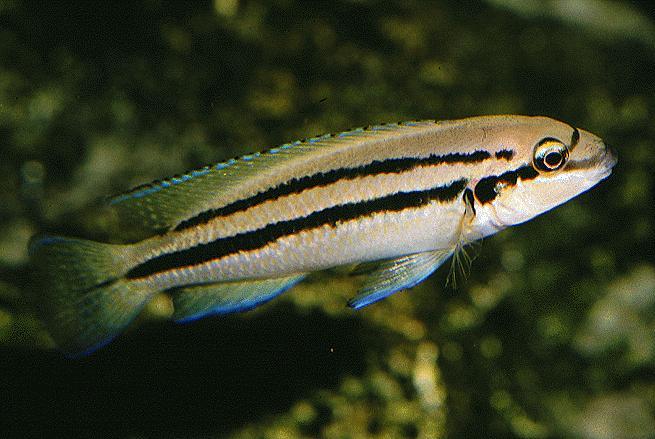While Telmatochromis bifrenatus don’t have the brilliant colors or extensive finnage of many other Lake Tanganyikan cichlids, nonetheless they have much to recommend them. For one thing, their shape is unusual, to say the least. Their elongated body seems out of place considering their round, blunt head. T. bifrenatus almost appears to be cross between a cichlid and an eel! T. bifrenatus is also blessed with a small size, the adults growing about three inches total length, making them perfect for tanks as small as ten gallons. Additionally, they are very peaceful, at least with other Tanganyikan cichlids.

I am currently keeping nearly half a dozen or so T. bifrenatus in a 55 gallon tank, together with Telmatochromis caninus, Julidochromis ornatus, Neolamprologus cylindricus, N. caudopunctatus, N. leleupi, N. buescheri, Altolamprologus calvus, Lamprologus brichardi, and Cyprichromis leptosoma.
A word about feeding: I feed all my fish, from discus to Congo tetras to mbuna, flakes in the morning, and pre-soaked Hikari Koi staple pellets in the evening, after work. (This was an accident. I kept, and bred, fancy goldfish for several years, and fed them pre-soaked Hikari Koi Staple. When my discus ate it with gusto, I began feeding this inexpensive food to everything I own, and the results have been quite satisfactory). Later on in the evening, I feed whatever live food is convenient – sometimes it may be whiteworms, other times it may be frozen adult brine shrimp or frozen bloodworms. During this hot summer, mosquito larvae has been my food of choice.
Breeding T. bifrenatus didn’t present much of a problem. I bought a few small fish at an auction in Cincinnati, plunked them in the above mentioned 55-gallon aquarium, and a few months later (or less – I really can’t remember) they began a bizarre courtship I had never witnessed in cichlids, or any other fish I’ve kept. One of the fish – the male I guess, it was the larger of the two – performed a rapid forward and backward, eel-like motion in a wide, up and down crescent direction. It’s hard to describe, but that’s about the best I can do.
Needless to say, I wanted to see more of this breeding behavior, so I tore the 55 down – a lot of work considering it was filled with rocks, live plants and driftwood – and transferred the pair to a twenty-gallon high set up with plenty of rock work, an empty marine snail shell and floating Java moss. Of course, they both hid completely after the move, and I never again witnessed the same behavior they exhibited in the larger tank. Actually, they hid almost completely, and I seldom caught a glimpse of them. Dammit.
Anyway, I pretty much forgot about the pair of T. bifrenatus. I kept feeding them well, and doing bi-weekly water changes, but assumed they would not breed. Then, a couple of weeks later, my wife, Sheri, called me over to the tank, saying, “Honey, are these fry in this tank?” – Yes, the fish had bred by themselves.
The young were easy to raise. Newly-hatched brine shrimp are a perfect food for both fry and adults. Young T. bifrenatus grow quickly, and are quite hardy. Dried food is accepted well. Newly-hatched brine shrimp are better. Six months later, the young from my first spawn are now pairing off in the Tanganyikan tank, staking out territories in scattered marine snail shells.
T. bifrenatus are easy to keep and breed, and every aquarist I’ve introduced them to has liked them. I’d have to give T. bifrenatus a hearty “thumbs-up,” and I recommend them with no reservations – something I can say about few other fish.
Leave a Reply